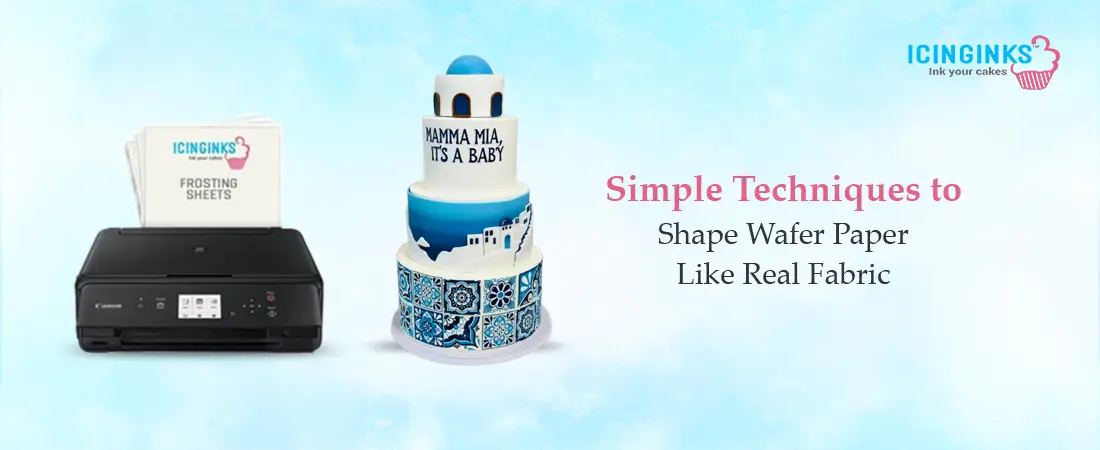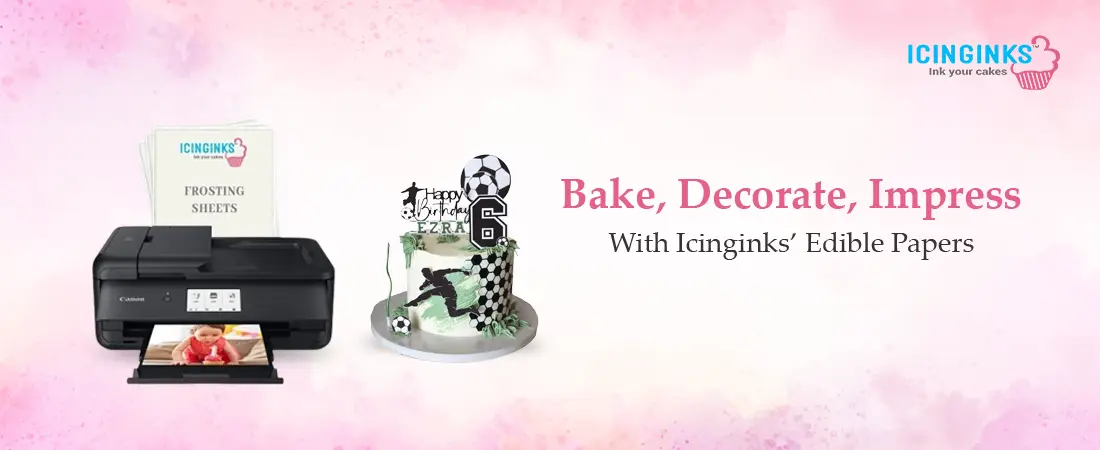
Picture a wedding cake draped in delicate, flowing ruffles—so realistic they look like silk. Now imagine those ruffles are entirely edible! It may seem like magic, but you can create this stunning effect with the right technique.
Wafer paper, a thin and lightweight edible paper, has become a favorite among cake artists for its versatility. Whether you're crafting delicate flowers, intricate lace, or elegant fabric-like folds, wafer paper offers endless creative possibilities. Unlike frosting sheets, which are thicker and more opaque, wafer paper can be softened and shaped to mimic the look of real fabric, making it perfect for adding sophisticated textures to cakes.
In this step-by-step guide, we'll show you how to transform wafer paper into edible fabric. With the right tools and techniques, you can create breathtaking designs that will enhance your cake decorating skills to the next level. Let's get started!
What is Wafer Paper?
Wafer paper is an edible, lightweight, and slightly translucent sheet made from potato starch, water, and vegetable oil. Unlike frosting sheets with a thicker and smoother surface, wafer paper is known for its ability to be molded, layered, and shaped into delicate structures, making it a favorite among cake artists. Whether you’re creating ruffles, bows, or even lifelike lace patterns, wafer paper provides endless creative possibilities.
Tools and Materials You'll Need
Before you start transforming wafer paper into edible fabric, gather the following tools and materials:
- Wafer paper (various thicknesses)
- Edible glue or water
- Airbrush or food-safe brush
- Vegetable glycerin
- Rolling pin or silicone mat
- Cutting tools (scissors or craft knife)
- Edible dust or petal dust for coloring
- Piping gel (optional for extra flexibility)
Step 1: Softening the Wafer Paper
To achieve a fabric-like texture, wafer paper must be softened without making it too wet, as excess moisture can cause it to dissolve or become sticky. Here’s how you can do it:
- Lightly mist the wafer paper with water using a fine spray bottle. Avoid over-saturating it.
- Apply a small amount of vegetable glycerin with a brush to enhance flexibility.
- Let it sit for a minute until the paper feels pliable but not soggy.
This step is crucial in ensuring that the edible paper maintains its structure while becoming more fabric-like in texture.
Step 2: Creating Ruffles and Folds
Once your wafer paper is softened, you can start shaping it into fabric-like designs. To create ruffles:
- Cut the wafer paper into strips of your desired width.
- Using a ball tool or your fingers, gently roll and shape the edges to form delicate frills.
- Attach the ruffles to a cake or edible surface using edible glue or a small dab of water.
For larger fabric folds, you can drape softened wafer paper over a rolling pin or a foam pad and allow it to dry in place to hold the shape.
Step 3: Adding Color and Texture
Edible fabric looks more realistic when it has depth and dimension. To enhance the visual appeal of your creation:
- Use an airbrush to apply soft layers of edible dust for a gradient effect.
- Add hand-painted details with food-safe paints to create intricate patterns.
- Apply a small amount of cornstarch to remove excess shine and create a matte finish resembling real fabric.
If you want a silk-like effect, consider adding a sheen to your wafer paper creation with a mixture of piping gel and a tiny amount of edible dust.
Step 4: Securing the Fabric Design
Once you have shaped and colored your edible fabric, it’s time to secure it in place. Here’s how:
- Use small amounts of edible glue to attach ruffles and folds to your cake or base structure.
- Allow the pieces to dry fully before moving them to prevent tearing.
- If making standalone edible fabric decorations, place them on a non-stick surface to dry completely before handling.
Common Mistakes to Avoid
Even experienced cake decorators encounter challenges when working with edible paper. Here are some common pitfalls and how to avoid them:
- Overwetting the wafer paper – This can cause it to dissolve or lose its structure. Always use minimal moisture.
- Skipping the drying step – Allowing the fabric to set properly prevents unwanted folds or breakage.
- Using too much glue – Excess glue can make the paper soggy and difficult to work with. Use a light touch.
- Ignoring storage conditions – Humidity can warp or curl wafer paper. Store unused sheets in a cool, dry place.
Why Use Wafer Paper Instead of Frosting Sheets?
While both wafer paper and frosting sheets are used in cake decorating, wafer paper is better suited for fabric-like textures because of its lightweight and moldable nature. Frosting sheets, being thicker and more opaque, work well for printed images but lack the flexibility needed for delicate ruffles and folds. If you aim for soft, flowing designs, wafer paper is the best choice.
Why Use Wafer Paper Instead of Other Edible Paper?
While various edible papers are available for cake decorating, wafer paper is lightweight and moldable. Unlike frosting sheets, which are thicker and more opaque, wafer paper can be softened and shaped into delicate ruffles, folds, and even lace-like textures, making it ideal for creating fabric-inspired designs.
If you want soft, flowing cake effects, wafer paper is the best choice. It holds its shape without cracking, allowing decorators to craft intricate, realistic details effortlessly. While frosting sheets are great for high-quality edible prints, they lack the flexibility to create fabric-like designs. Whether you're designing elegant drapes, floral accents, or fine patterns, wafer paper offers unmatched versatility in cake artistry.
Icinginks: Turn Ordinary Cakes into Edible Art with Premium Edible Papers

With Icinginks' range of edible papers, creating stunning, professional-quality cake decorations is effortless. Our Wafer Paper, crafted from natural ingredients like potato starch and vegetable oil, offers a versatile medium for creating intricate designs and textures. It is a favorite among bakers seeking precision and elegance and is ideal for printing edible images, cake toppers, and delicate shapes such as flowers and feathers. ?
Icinginks' Edible Frosting Sheets are the perfect choice for those aiming for vibrant, high-resolution edible prints. These thin, flavorless icing sheets come with an easy-to-peel plastic backing, ensuring seamless printing with edible inks. Compatible with all edible printers, our frosting sheets are designed to produce vivid images that blend seamlessly into your cakes, cupcakes, and cookies. ?
At Icinginks, we prioritize quality and safety. Our edible papers are allergen-free, gluten-free, and nut-free, catering to various dietary needs. Whether you're a professional baker or a home enthusiast, our products provide the reliability and excellence required to bring your creative visions to life.?
Explore our extensive range of edible papers and discover how Icinginks can transform your cake decorating projects into edible masterpieces.
FAQs
1. How do you make wafer paper flexible for fabric-like designs?
To make wafer paper flexible, lightly mist it with water or a food-safe glycerin mixture. This softens the paper, allowing you to fold, ruffle, or shape it into delicate fabric-like textures. Be cautious not to oversaturate, as too much moisture can cause the paper to dissolve.
2. What is the best way to attach wafer paper decorations to cakes?
Wafer paper decorations can be attached using a thin layer of edible glue, piping gel, or even water. If working with buttercream or fondant cakes, gently press the wafer paper onto the surface while it's slightly tacky for better adhesion. Avoid excessive moisture to maintain the paper’s structure.
3. Can you color or paint wafer paper?
Yes! Wafer paper can be colored using edible dust, airbrushing, or food coloring diluted with alcohol or lemon extract. Blend colors gradually with a brush or sponge for a soft, fabric-like effect. Avoid using too much liquid, which can weaken the paper and cause curling.
4. How do you store wafer paper decorations before using them?
Store wafer paper decorations in a cool, dry place away from humidity and direct sunlight. To prevent moisture absorption, keep them in an airtight container with silica gel packets. When stored properly, wafer paper decorations can last for months without losing their shape or texture.
5. What types of cakes work best with wafer paper fabric designs?
Wafer paper fabric designs work beautifully on fondant-covered cakes and smooth buttercream surfaces. They adhere well to firm bases and provide a stunning visual effect. If using buttercream, apply decorations just before serving to prevent moisture from softening the paper too much.
Related Post:
Does Wafer Paper Thickness Matter? A Quick Breakdown
Wafer Sheets: A Budget-Friendly Solution for Event Decor
Difference Between Wafer Paper and Frosting Sheets: A Detailed Guide




